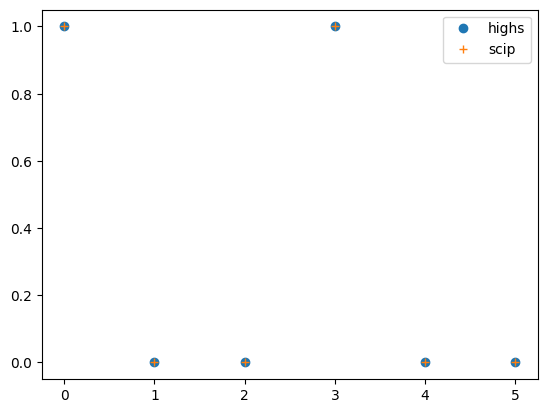Solve with multiple adapters and compare the results#
Since the OMMX Adapter provides a unified API, you can solve the same problem using multiple solvers and compare the results. Let’s consider a simple knapsack problem as an example:
\[\begin{split}
\begin{align*}
\mathrm{maximize} \quad & \sum_{i=0}^{N-1} v_i x_i \\
\mathrm{s.t.} \quad & \sum_{i=0}^{n-1} w_i x_i - W \leq 0, \\
& x_{i} \in \{ 0, 1\}
\end{align*}
\end{split}\]
from ommx.v1 import Instance, DecisionVariable
v = [10, 13, 18, 31, 7, 15]
w = [11, 25, 20, 35, 10, 33]
W = 47
N = len(v)
x = [
DecisionVariable.binary(
id=i,
name="x",
subscripts=[i],
)
for i in range(N)
]
instance = Instance.from_components(
decision_variables=x,
objective=sum(v[i] * x[i] for i in range(N)),
constraints=[sum(w[i] * x[i] for i in range(N)) - W <= 0],
sense=Instance.MAXIMIZE,
)
Solve with multiple adapters#
Here, we will use OSS adapters developed as a part of OMMX Python SDK. For non-OSS solvers, adapters are also available and can be used with the same interface. A complete list of supported adapters for each solver can be found in Supported Adapters.
Here, let’s solve the knapsack problem with OSS solvers, Highs, SCIP.
from ommx_highs_adapter import OMMXHighsAdapter
from ommx_pyscipopt_adapter import OMMXPySCIPOptAdapter
# List of adapters to use
adapters = {
"highs": OMMXHighsAdapter,
"scip": OMMXPySCIPOptAdapter,
}
# Solve the problem using each adapter
solutions = {
name: adapter.solve(instance) for name, adapter in adapters.items()
}
Compare the results#
Since this knapsack problem is simple, all solvers will find the optimal solution.
from matplotlib import pyplot as plt
marks = {
"highs": "o",
"scip": "+",
}
for name, solution in solutions.items():
x = solution.extract_decision_variables("x")
subscripts = [key[0] for key in x.keys()]
plt.plot(subscripts, x.values(), marks[name], label=name)
plt.legend()
<matplotlib.legend.Legend at 0x7f5e115ed250>

It would be convenient to concatenate the pandas.DataFrame obtained with decision_variables_df when analyzing the results of multiple solvers.
import pandas
decision_variables = pandas.concat([
solution.decision_variables_df.assign(solver=solver)
for solver, solution in solutions.items()
])
decision_variables
| kind | lower | upper | name | subscripts | description | substituted_value | value | solver | |
|---|---|---|---|---|---|---|---|---|---|
| id | |||||||||
| 0 | Binary | 0.0 | 1.0 | x | [0] | <NA> | <NA> | 1.0 | highs |
| 1 | Binary | 0.0 | 1.0 | x | [1] | <NA> | <NA> | 0.0 | highs |
| 2 | Binary | 0.0 | 1.0 | x | [2] | <NA> | <NA> | 0.0 | highs |
| 3 | Binary | 0.0 | 1.0 | x | [3] | <NA> | <NA> | 1.0 | highs |
| 4 | Binary | 0.0 | 1.0 | x | [4] | <NA> | <NA> | 0.0 | highs |
| 5 | Binary | 0.0 | 1.0 | x | [5] | <NA> | <NA> | 0.0 | highs |
| 0 | Binary | 0.0 | 1.0 | x | [0] | <NA> | <NA> | 1.0 | scip |
| 1 | Binary | 0.0 | 1.0 | x | [1] | <NA> | <NA> | 0.0 | scip |
| 2 | Binary | 0.0 | 1.0 | x | [2] | <NA> | <NA> | 0.0 | scip |
| 3 | Binary | 0.0 | 1.0 | x | [3] | <NA> | <NA> | 1.0 | scip |
| 4 | Binary | 0.0 | 1.0 | x | [4] | <NA> | <NA> | 0.0 | scip |
| 5 | Binary | 0.0 | 1.0 | x | [5] | <NA> | <NA> | 0.0 | scip |


